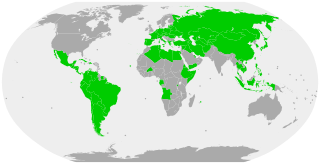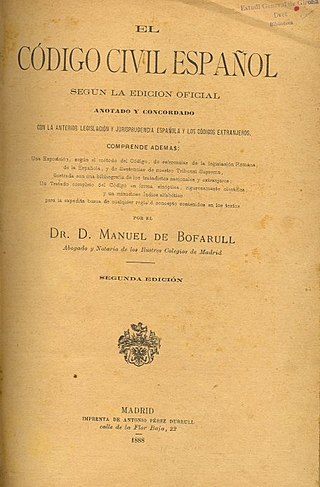Related Research Articles

Roman law is the legal system of ancient Rome, including the legal developments spanning over a thousand years of jurisprudence, from the Twelve Tables, to the Corpus Juris Civilis ordered by Eastern Roman emperor Justinian I. Roman law forms the basic framework for civil law, the most widely used legal system today, and the terms are sometimes used synonymously. The historical importance of Roman law is reflected by the continued use of Latin legal terminology in many legal systems influenced by it, including common law.
In law, a judgment, also spelled judgement, is a decision of a court regarding the rights and liabilities of parties in a legal action or proceeding. Judgments also generally provide the court's explanation of why it has chosen to make a particular court order.

The Civil Code of Quebec is the civil code in force in the Canadian province of Quebec, which came into effect on January 1, 1994. It replaced the Civil Code of Lower Canada enacted by the Legislative Assembly of the Province of Canada in 1865, which had been in force since August 1, 1866.

A civil code is a codification of private law relating to property, family, and obligations.
The Bürgerliches Gesetzbuch, abbreviated BGB, is the civil code of Germany, codifying most generally-applicably private law. In development since 1881, it became effective on 1 January 1900, and was considered a massive and groundbreaking project.

Civil law is a legal system originating in Italy and France and adopted in much of the world. The civil law system is intellectualized within the framework of Roman law and French civil law, and with core principles codified into a referable system, which serves as the primary source of law. The civil law system is often contrasted with the common law system, which originated in medieval England. Whereas the civil law takes the form of legal codes, the law in common law systems historically came from uncodified case law that arose as a result of judicial decisions, recognising prior court decisions as legally binding precedent.

The Swiss Civil Code is a portion of the second part of the internal Swiss law that regulates the codified law ruling in Switzerland and relationship between individuals. It was first adopted in 1907.

Law in the state of Louisiana is based on a more diverse set of sources than the laws of the other 49 states of the United States. Private law—that is, substantive law between private sector parties, principally contracts and torts—has a civil law character, based on French and Spanish codes and ultimately Roman law, with some common law influences. Louisiana's criminal law largely rests on American common law. Louisiana's administrative law is generally similar to the administrative law of the federal government and other states. Louisiana's procedural law is generally in line with that of other U.S. states, which in turn is generally based on the U.S. Federal Rules of Civil Procedure.

The Civil Code of the Philippines is the product of the codification of private law in the Philippines. It is the general law that governs family and property relations in the Philippines. It was enacted in 1950, and remains in force to date with some significant amendments.

Canadian contract law is composed of two parallel systems: a common law framework outside Québec and a civil law framework within Québec. Outside Québec, Canadian contract law is derived from English contract law, though it has developed distinctly since Canadian Confederation in 1867. While Québecois contract law was originally derived from that which existed in France at the time of Québec's annexation into the British Empire, it was overhauled and codified first in the Civil Code of Lower Canada and later in the current Civil Code of Quebec, which codifies most elements of contract law as part of its provisions on the broader law of obligations. Individual common law provinces have codified certain contractual rules in a Sale of Goods Act, resembling equivalent statutes elsewhere in the Commonwealth. As most aspects of contract law in Canada are the subject of provincial jurisdiction under the Canadian Constitution, contract law may differ even between the country's common law provinces and territories. Conversely; as the law regarding bills of exchange and promissory notes, trade and commerce, maritime law, and banking among other related areas is governed by federal law under Section 91 of the Constitution Act, 1867; aspects of contract law pertaining to these topics are harmonised between Québec and the common law provinces.

This article deals primarily with the nature of Italian citizenship from the time of unification to the present. It is concerned with the civil, political, and social rights and obligations of Italian nationals and addresses how these rights and obligations have been changed or manipulated throughout the last two centuries.

The Civil Code of the Republic of Chile is the work of jurist and legislator Andrés Bello. After several years of individual work, Bello delivered a complete project of the Code on November 22, 1855, which was sent to Congress by President Manuel Montt, preceded by a foreword by Bello himself. Congress passed the Civil Code into law on December 14, 1855. It then came into force on January 1, 1857. Although it has been the object of numerous alterations, the Code has been kept in force since then.

The Ente Nazionale per l'Aviazione Civile (ENAC), English: Italian Civil Aviation Authority, is the civil aviation authority of Italy. Its headquarters are located in Rome. Legislative Decree no.250/97 established the existence of ENAC on 25 July 1997. It is the equivalency of the United States Federal Aviation Administration.

The Swiss Criminal Code is a portion of the third part of the internal Swiss law that regulates the criminal code in Switzerland. The original version was created on 21 December 1937. It entered into force on 1 January 1942. Previously, criminal law had been a cantonal competency.
Provisions related to Italian copyright law are found in Law no. 633 of 22 April 1941. Certain fundamental provisions are also found in the Italian Civil Code of 1942, Arts. 2575–2583.

The law of Italy is the system of law across the Italian Republic. The Italian legal system has a plurality of sources of production. These are arranged in a hierarchical scale, under which the rule of a lower source cannot conflict with the rule of an upper source.

The Italian law codes constitute the codified law of Italy.

The Civil Code of Spain, formally the Royal Decree of 24 July 1889 is the law that regulates the major aspects of Spanish civil law. It is one of the last civil codes in Continental Europe because of the sociopolitical, religious and territorial tensions that dominated 19th-century Spain. The code has been modified numerous times and remains in force.
The Civil Code of Ukraine is a single normative legal act; Law of Ukraine, which is the main act of regulation of private law relations in Ukraine. It regulates personal non-property and property relations, based on legal equality, free will, property independence of their participants. It was adopted by the Verkhovna Rada of Ukraine on 16 January 2003.

The Civil Code of the People's Republic of China, or in short Minfadian is the first complete civil code in the People's Republic of China. Effective January 1, 2021, the introduction of the civil code is the first time a unified civil law framework has been created to integrate most of the former substantial civil substantive laws in China.
References
- 1 2 3 Perlingieri, Pietro (2017). Manuale di diritto civile (8 ed.). Napoli: Edizioni scientifiche italiane. ISBN 884953261X.